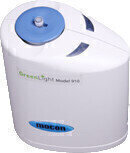Water/Wastewater
Live Bacteria Measurements
Apr 09 2012
Baseline-MOCON (USA) launches a new fast, accurate and cost-effective way to measure live bacteria loads and improve disinfection efficiency for water environments. For the first time, bacteria can be measured in as fast as 45 minutes vs. the 24-48 hours needed with traditional methods.
The new GreenLight Environmental series is ideal for testing of waste, drinking, surface, ground and bottled water operations, as well as beaches, water parks, etc.
The leading-edge technology uses a sensor which measures respiration of aerobic bacteria and equates the change in oxygen level to the viable microbial load in a sample. The amount of bacteria in the water/wastewater determines how much oxygen is depleted. Non-disinfected final effluent reaches the threshold within 45 minutes, ultraviolet (UV) disinfected final effluent reaches the threshold within 6 hours. Speed is dependent on the number of colony forming units present.
“Not only does the new GreenLight technology save time, but it also significantly decreases energy costs for operations using UV light disinfection. Up until now, these waste and surfacewater treatment environments have had to run all their lamps at full power to make sure they were controlling bacteria levels. GreenLight’s ability to provide accurate data faster than any other testing protocol will enable improved process control which, in turn, will dramatically reduce utility costs,” Adam Gniewek, Sales & Marketing, Baseline-MOCON, Inc.
Wastewater operations which still rely on traditional chlorine disinfection can also benefit from GreenLight’s ability to provide faster results in a cost-effective manner.
For recreational environments, such as beaches and parks, GreenLight’s portability and testing speed means that decisions, such as closings due to high contaminant levels, can be made more rapidly and accurately.
“Another benefit is that the GreenLight instrument is portable and can be operated by unskilled labor. Traditional methods typically require that samples be transported to a lab and evaluated by highly-skilled technicians. This means that a lifeguard or wastewater plant worker can be trained within 30 minutes to perform the test onsite,” Adam said.
Digital Edition
IET 34.2 March 2024
April 2024
Gas Detection - Biogas batch fermentation system for laboratory use with automatic gas analysis in real time Water/Wastewater - Upcycling sensors for sustainable nature management - Prist...
View all digital editions
Events
Apr 30 2024 Melbourne, Australia
Apr 30 2024 Birmingham, UK
May 03 2024 Seoul, South Korea
May 05 2024 Seville, Spain
May 06 2024 Minneapolis, MN, USA


















